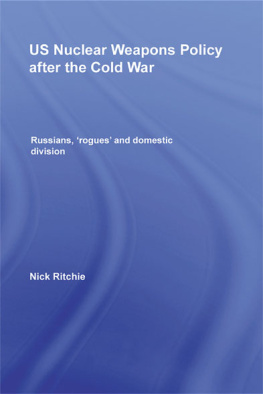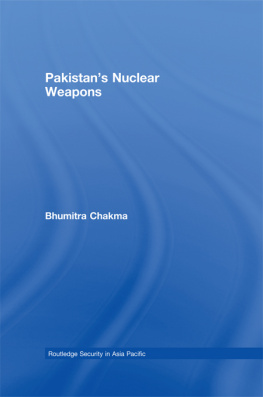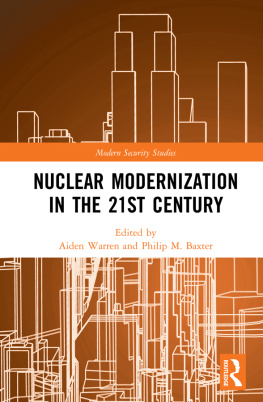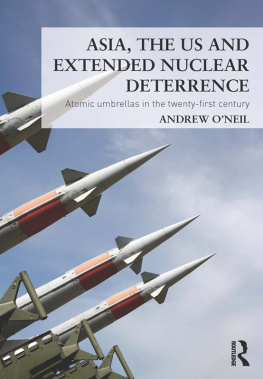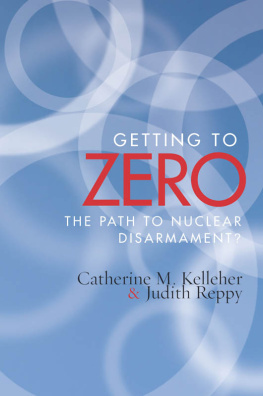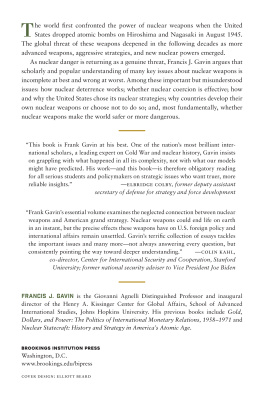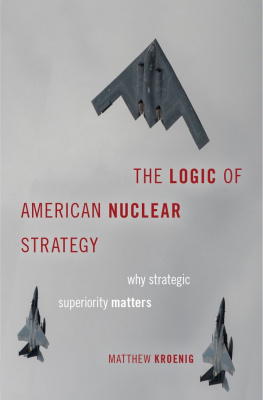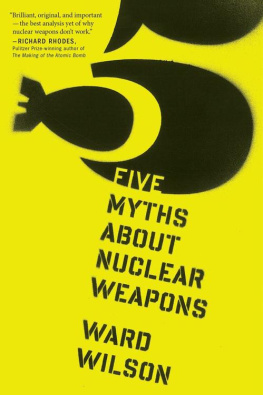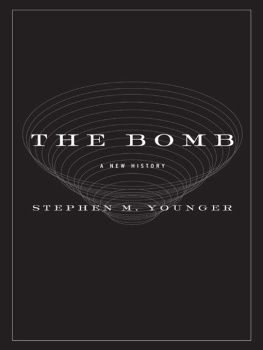Stanford University Press
Stanford, California
2016 by the Board of Trustees of the Leland Stanford Junior University. All rights reserved.
No part of this book may be reproduced or transmitted in any form or by any means, electronic or mechanical, including photocopying and recording, or in any information storage or retrieval system without the prior written permission of Stanford University Press.
Printed in the United States of America on acid-free, archival-quality paper
Library of Congress Cataloging-in-Publication Data
Roberts, Brad, author.
The case for U.S. nuclear weapons in the 21st century / Brad Roberts.
pages cm
Includes bibliographical references and index.
ISBN 978-0-8047-9645-3 (cloth : alk. paper) ISBN 978-0-8047-9713-9 (pbk. : alk. paper)
1. Nuclear weaponsGovernment policyUnited States. 2. Deterrence (Strategy) 3. National securityUnited States. 4. United StatesMilitary policy. 5. United StatesForeign relations21st century. I. Title.
UA23.R59 2015
355.02'170973dc23
2015016028
ISBN 978-0-8047-9715-3 (electronic)
Typeset by Thompson Type in 10/14 Minion
THE CASE FOR U.S. NUCLEAR WEAPONS IN THE 21st CENTURY
Brad Roberts
Stanford Security Studies
An Imprint of Stanford University Press
Stanford, California
This volume is dedicated to Thrse Delpecha friend, colleague, and mentor taken by cancer too early in life in January 2012. By those who knew her, she is remembered for her clarity of policy vision, her willingness to challenge conventional wisdom and weak leadership, and her deep conviction that the strength of the democracies will be a deciding factor in the battle against savagery in the 21st century, just as it was in the 20th. She was an inspiration, and this volume is guided by her values.
Contents
Acknowledgments
THIS VOLUME WAS WRIT TEN AT STANFORD UNIVERSITY IN 2014. It was my pleasure and honor to serve as a consulting professor and a William Perry Fellow at the Center for International Security and Cooperation (CISAC) from September 2013 to December 2014. I am grateful to the university for this opportunity. I am grateful also to Los Alamos and Lawrence Livermore national laboratories for their support of the fellowship.
The arguments presented here were strengthened significantly through exchanges and debates with the faculty and students at Stanford. I am grateful especially to participants in a manuscript review session at CISAC in October 2014. I had many additional opportunities to review this work with colleagues in multiple academic and research institutions in the United States and elsewhere, which also greatly enriched my thinking. I wish to express special thanks to the following individuals for their willingness to review and critique the manuscript or elements of it: Daniel Altman, Michael Armacost, Ivanka Barshazka, Robert Bell, Coit Blacker, Lynn Eden, Tom Fingar, David Holloway, Miriam John, Vince Manzo, Michael May, Sean McDonald, Michael McFaul, Patrick McKenna, James Miller, Michael Nacht, Jonathan Pearl, Joseph Pilat, Mira Rapp-Hooper, Nicolas Roche, Scott Sagan, William Schlickenmaier, Shane Smith, Jonathan Trexel, Christopher Twomey, Michael Urena, Victor Utgoff, Robert Vince, Ted Warner, James Wirtz, and David Yost. I owe a special debt of gratitude to Linton Brooks and Lewis Dunn for exceptional assistance in developing the ideas contained here.
This work could not have been concluded successfully without the valuable research assistance of Jaclyn Marcatili and Marilyn Harris. And it could not have been published in such fine form without the support of Geoffrey Burns, James Holt, and Margaret Pinette.
More generally, I am indebted to the large community of people, both outside and inside government, and in the United States and abroad, with whom I have discussed and debated for many years our changing world and emerging challenges of deterrence, assurance, and strategic stability. The views expressed here are my own and should not be attributed to any institution with which I am or have been affiliated.
Introduction
THE UNITED STATES IS ENTERING A PERIOD OF RENEWED debate about nuclear deterrence. That debate will address the most fundamental question: Are U.S. nuclear weapons merely Cold War relics that belong in the dustbin of history along with communism and the Soviet Union, or do they make an important and irreplaceable contribution to the national security of the United States?
This debate will be driven by three key factors. The first is the reassessment of U.S. defense strategy after fifteen years of war in Afghanistan and Iraq. A number of questions come into play. Is a shift away from counter-terrorism and counter-insurgency possible for U.S. military planners? Is the intended rebalance of security strategy toward Asia possible given widespread instability in the Middle East and Russian assertiveness in Europe? Is limited war with China and/or Russia a serious possibility? Is war with North Korea likely; if so, how might it exploit its new military capabilities to try to secure its interests? Will Iran go nuclear and with what implications for U.S. military strategies? What can the United States do to constructively shape developments in the Middle East while insulating itself and its allies and partners from the effects of deep and sustained conflict there? Answers to each of these questions have important implications for U.S. nuclear policy and posture.
Developments in the security environment that call into question some of the premises of U.S. policy since the end of the Cold War also play a role in driving renewed debate. The profound changes in Russias foreign policy in 2014 have raised fundamental questions about the future role of nuclear weapons in Europe and in U.S.Russian relations more generally. North Koreas progress in developing weapons capable of reaching the United States highlights an emerging major challenge to U.S. security strategy. China is making significant progress in deploying the key elements of a secure nuclear retaliatory force. Some U.S. allies in Europe, Asia, and the Middle East feel pressured by these developments and are seeking new forms of assurance that the U.S. security commitment to them will remain credible over the long term. New premises might well drive U.S. nuclear policy in new directions.
In addition, policy makers in Washington need to decide whether and how much to invest in keeping U.S. nuclear forces viable. For the last twenty-five years or so, the United States has spent only the money needed to operate and maintain standing nuclear forces. It has not had to modernize or replace them. Over the next twenty-five years or so, the entire remaining triad of delivery systems and inventory of weapons will have to be modernized or replaced in some way. These will be inherently contentious decisions, not least because they come at a time of budget austerity and in competition with the need to renew nonnuclear forces after more than a decade of war in Iraq and Afghanistan.
But the United States is ill prepared for this debate. Most of the stakeholders in the debate about U.S. nuclear deterrence policy and posture made up their minds a long time ago about the big questions. They generally fall into two camps with different core beliefs.
One camp recoils from the horror of nuclear war, sees the risks of nuclear terrorism as high, seeks the abolition of nuclear weapons, and advocates strongly for steps by the nuclear weapons states toward that end. It places a particular onus on the United States to take additional substantial steps at this time to reduce its reliance on nuclear weapons and otherwise lead by example. It makes a passionate case against nuclear weapons and for disarmament.



